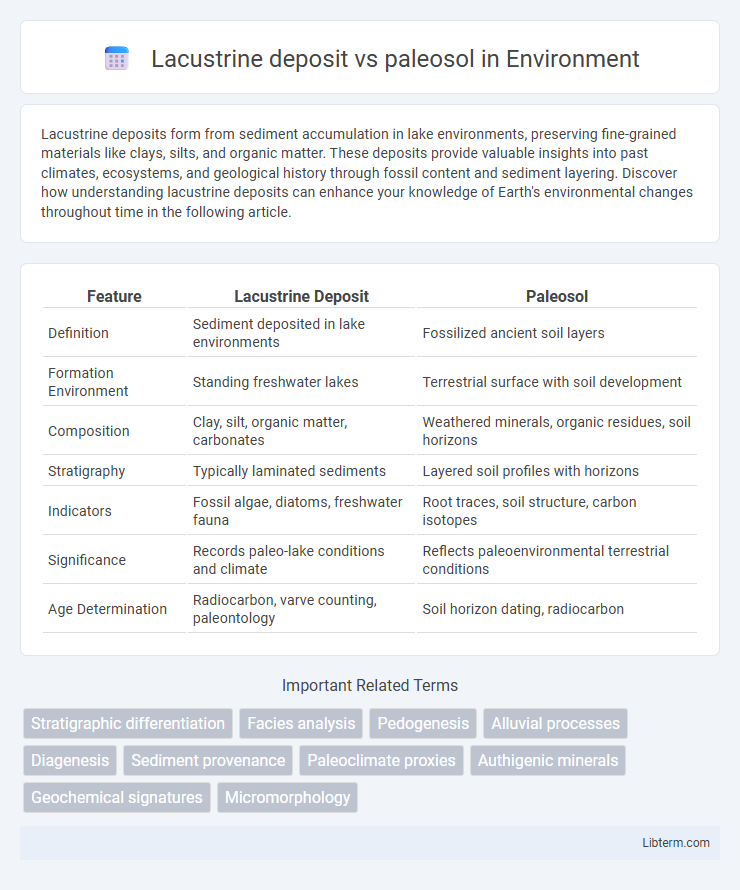Lacustrine deposits form from sediment accumulation in lake environments, preserving fine-grained materials like clays, silts, and organic matter. These deposits provide valuable insights into past climates, ecosystems, and geological history through fossil content and sediment layering. Discover how understanding lacustrine deposits can enhance your knowledge of Earth's environmental changes throughout time in the following article.
Table of Comparison
| Feature | Lacustrine Deposit | Paleosol |
|---|---|---|
| Definition | Sediment deposited in lake environments | Fossilized ancient soil layers |
| Formation Environment | Standing freshwater lakes | Terrestrial surface with soil development |
| Composition | Clay, silt, organic matter, carbonates | Weathered minerals, organic residues, soil horizons |
| Stratigraphy | Typically laminated sediments | Layered soil profiles with horizons |
| Indicators | Fossil algae, diatoms, freshwater fauna | Root traces, soil structure, carbon isotopes |
| Significance | Records paleo-lake conditions and climate | Reflects paleoenvironmental terrestrial conditions |
| Age Determination | Radiocarbon, varve counting, paleontology | Soil horizon dating, radiocarbon |
Introduction to Lacustrine Deposits and Paleosols
Lacustrine deposits consist of sediments accumulated in lake environments, characterized by fine-grained materials like clays, silts, and organic-rich layers, reflecting past hydrological and climatic conditions. Paleosols are ancient soil horizons preserved in the geological record, providing insights into past terrestrial ecosystems, climate, and surface processes through features such as root traces, soil horizons, and mineral alterations. Understanding the distinction between lacustrine deposits and paleosols aids in reconstructing paleoenvironmental settings and sedimentary processes in terrestrial basins.
Geological Formation Processes: Lacustrine vs. Paleosol
Lacustrine deposits form through sedimentation in lake environments, characterized by fine-grained silts, clays, and organic materials accumulating in standing water with periodic fluctuations in water chemistry and sediment supply. Paleosols develop through soil formation processes on terrestrial surfaces, involving weathering, biological activity, and pedogenic alteration of sediments under subaerial conditions, resulting in distinct horizons reflecting past climatic and environmental conditions. The contrasting geological formation processes highlight lacustrine deposits as primarily sedimentary and aquatic in origin, whereas paleosols represent terrestrial pedogenic transformations of previously deposited materials.
Key Characteristics of Lacustrine Deposits
Lacustrine deposits consist primarily of fine-grained sediments like clays, silts, and muds, often showing laminations or varves indicative of seasonal sedimentation in lake environments. These deposits typically exhibit well-preserved organic matter and fossil assemblages adapted to aquatic conditions, contrasting with the oxidized horizons and root traces characteristic of paleosols. Key sedimentological features include uniform texture, low energy depositional structures, and chemical signatures such as higher carbonate content reflecting the lacustrine water chemistry.
Distinguishing Features of Paleosols
Paleosols are ancient soil horizons characterized by distinct soil structures, root traces, and horizonation that indicate prolonged surface exposure and pedogenic processes, unlike lacustrine deposits which primarily consist of fine-grained sediments from lake environments. Paleosols often exhibit features such as clay illuviation, carbonate nodules, and soil aggregates, reflecting chemical weathering and biological activity absent in lacustrine sediments. These distinguishing morphological and geochemical markers enable the identification of paleosols within stratigraphic records, differentiating them from lacustrine deposits formed by sedimentation in aquatic settings.
Sedimentology: Texture, Structure, and Composition
Lacustrine deposits typically exhibit fine-grained textures such as silts and clays with well-laminated structures indicative of low-energy aqueous environments, often containing organic-rich layers and carbonate nodules. Paleosols display heterogeneous textures ranging from silty to clayey compositions with distinct soil horizons, root traces, and bioturbation features that reflect pedogenic processes. The mineralogy of lacustrine sediments often includes authigenic minerals like calcite and smectite, whereas paleosols are characterized by weathering products such as iron oxides and secondary clays, highlighting their formation through soil development rather than sediment deposition.
Paleoenvironmental Indicators in Lacustrine Deposits
Lacustrine deposits provide crucial paleoenvironmental indicators through sediment composition, fossil assemblages, and geochemical signatures that reflect ancient lake conditions. Variations in grain size, organic content, and mineralogy within lacustrine sediments reveal changes in water depth, salinity, and climate fluctuations. Unlike paleosols, which indicate subaerial exposure and soil formation processes, lacustrine deposits specifically record lacustrine hydrology and biotic activity essential for reconstructing past aquatic environments.
Paleosols as Records of Ancient Soil Formation
Paleosols represent ancient soil horizons that preserve evidence of past climate, vegetation, and atmospheric conditions, making them critical for reconstructing Earth's paleoenvironmental history. Unlike lacustrine deposits formed primarily by sedimentation in lake environments, paleosols retain features such as root traces, soil structures, and geochemical signatures indicative of in situ soil formation processes. These characteristics enable paleosols to serve as valuable archives for understanding terrestrial ecosystem evolution and long-term biogeochemical cycles.
Methods for Identifying Lacustrine Deposits and Paleosols
Methods for identifying lacustrine deposits include sedimentological analysis of fine-grained, laminated clay and silt layers, along with geochemical signatures such as elevated organic carbon content and specific mineral assemblages like calcite or aragonite. Paleosols are distinguished through soil horizon identification, presence of root traces, carbonate nodules, iron mottling, and micromorphological features indicating burial soil profiles. Stable isotope analysis and paleoenvironmental reconstruction techniques further differentiate lacustrine sediments, deposited in standing water bodies, from paleosols formed by long-term soil processes on terrestrial surfaces.
Importance in Paleoenvironmental Reconstruction
Lacustrine deposits provide essential data on past hydrological conditions and climate fluctuations, preserving fine-grained sediments and organic materials that reflect ancient lake environments. Paleosols offer critical insights into terrestrial climate, vegetation, and atmospheric composition through soil horizon characteristics and mineralogy, serving as direct evidence of subaerial exposure and weathering processes. Together, lacustrine deposits and paleosols enable comprehensive paleoenvironmental reconstructions by integrating aquatic and terrestrial ecosystem information.
Comparative Summary: Lacustrine Deposits and Paleosols
Lacustrine deposits are sedimentary layers formed in lake environments characterized by fine-grained sediments such as clays and silts, often preserving organic material and fossils indicating aquatic conditions. Paleosols represent ancient soil horizons developed on land surfaces, showing evidence of weathering, root structures, and soil formation processes, reflecting subaerial exposure and terrestrial ecosystems. Compared to lacustrine deposits, paleosols provide critical insights into paleoenvironmental conditions, climate change, and terrestrial biogeochemical cycles, while lacustrine deposits excel in recording hydrological and depositional histories within lacustrine basins.
Lacustrine deposit Infographic

 libterm.com
libterm.com